
The Western-style riding boot is somewhere between folk art, pop culture, and functional clothing.
Actors have worn them, and so have Presidents — and for that matter, so have actors who became Presidents.
Most men, though, will go through life without ever having tried a cowboy boot on.
My advice? Don’t be that guy. Give it a shot. You don’t have to be a cowboy to wear and appreciate Western boots.
Although you’ll get more use out of them if you take up Western dancing and rodeo — a man can enjoy a touch of Western style in his outfits now and again.
Just like boater shoes aren’t exclusively for New Englanders with their own private yachts, well-dressed men can be comfortable taking the cowboy boot out of the Southwest and into America’s most fashionable cities.
How to do it? Well that’s the purpose of this cowboy boot primer.
Why Western Boots?
For most men, it’s hard to see the point of a fancy Western boot. They’re expensive items, and unless you grew up around men who wore them, they seem more like novelty or costume pieces than anything stylish.
But a savvy dresser can think of a cowboy boot as an outfit’s holdout weapon. At a distance, it looks like a quality leather shoe. Up close, the distinct advantages start to show:
- Unique shape.
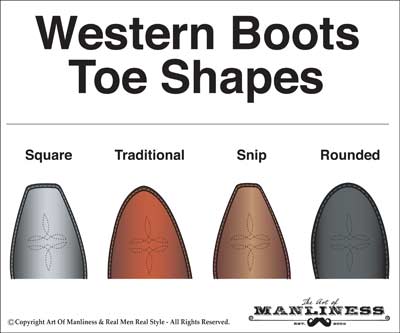
The toe of a cowboy boot doesn’t have to be wickedly thin (although modern fashion tends that way), but it always has a distinct taper. This was originally to help slide in and out of the stirrups more easily, and it still gives your feet an active, dynamic shape that contrasts nicely with more staid dress shoe toes. - Added height. Shorter men have extra reason to love cowboy boots — the heel adds anywhere from a half-inch to nearly two inches of height. Taller men will definitely want a lower-slung “walking heel” style, but particularly short men can sneak another inch or so in by wearing full “cowboy heels.”
- Decoration. A plain cowboy boot is a rare thing. There are styles out there for every taste imaginable, and the portion of the boot visible beneath your trouser cuffs can feature everything from leather tooling to contrast-colored stitching and bright vegetable dyes. If you’re fond of memorable footwear, you’ll love cowboy boots.
- Uniqueness. Once you get outside of Texas and the Southwest, you’re unlikely to find yourself in a room with another guy wearing Western boots. It gives people something to remember you by.
- Fun. Let’s face it, sometimes we all want to cowboy it up a little. Western boots come from a long tradition, both historical and fictional, of American independence and manhood. It’s fun to be a part of that.
Western Boot Parts & Terminology
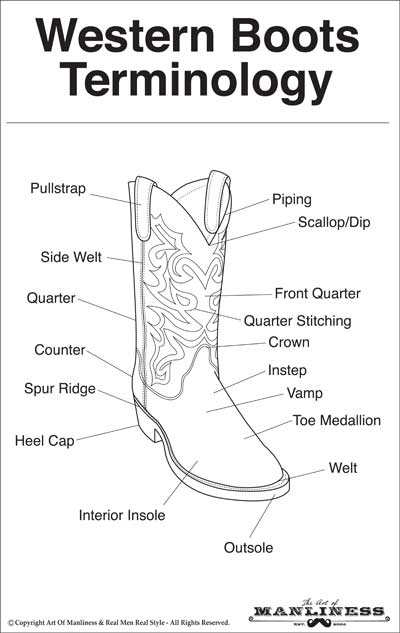
The first-time buyer is likely to be overwhelmed by the variety of Western boots out there. But if you know some basic terms and styles, it’ll be far less intimidating.
For the most part, all good Western boots should share the same basic characteristics:
Cuban heel. This is mandatory. A boot that doesn’t have an angled, underslung heel of at least 1/2″ or more isn’t really a cowboy boot. Lower heels will be more comfortable to walk in (and are in fact called “walking heels”), while taller heels are more useful for holding your feet in the stirrups when you ride, and give shorter men a bit of an extra boost. Expect heel length to be up to 2 inches, although 1 to 1.5 is normal.
High shaft. The tops of the boots should be up to at least mid-calf. The tops are usually shaped with decorative cut-outs, but can end in a plain, round opening. A classic Western boot usually has a 10- to 14-inch shaft.
No laces. Cowboy boots are pulled on and off. They usually have small leather loops (“bootstraps”) to assist with this, but should not have laces. This also comes from the practical origins; laces could catch on a stirrup when a cowboy fell from his horse or keep him from kicking free if the boot caught, causing him to be dragged and potentially trampled.
Want more information on Western boot heels, leathers, and parts? Click here to check out my detailed infographic.
Western Boot Styles
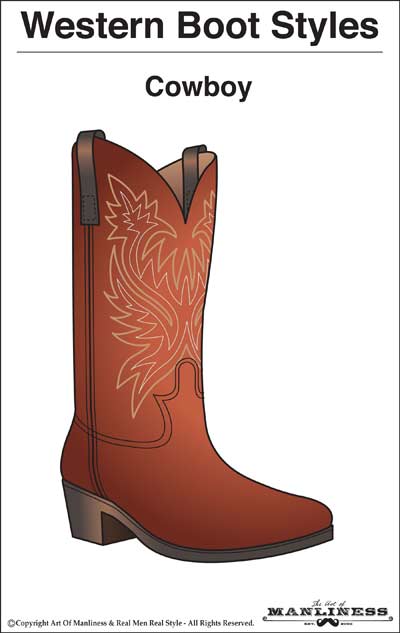
The classic Western boot style, otherwise known as the cowboy boot, stays true to its heritage by having a shaft about 12 inches high, a heel designed to keep you in the saddle, no laces, and a toe box that can protect your digits when a horse steps on them.
Classic cowboy style comes in a wide variety of leathers and stitching. Stick with cowhide for your first boot – it’s relatively inexpensive, has all the classic hard-wearing properties, and is more versatile than exotic leathers.
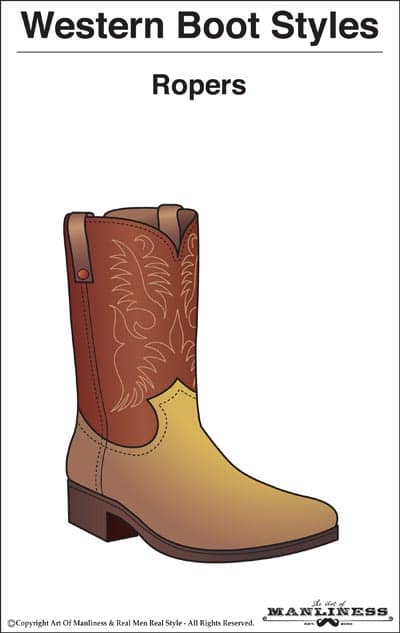
These are slightly different, and are designed specifically for rodeo use. They feature lower shafts, a more rounded toe, and a broader heel that’s shaped more like a typical work boot.
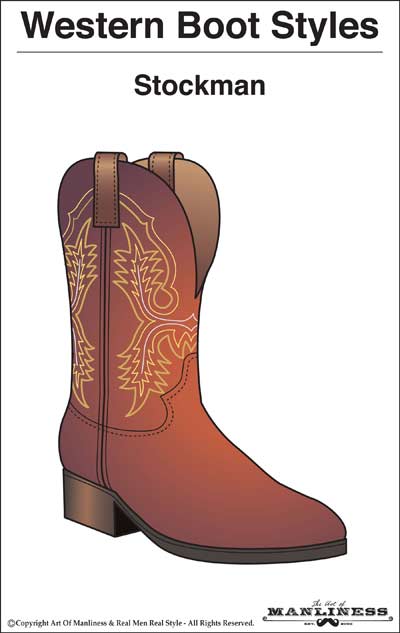
The stockman style of Western boot is very similar to the cowboy. The two most noticeable differences are a deeper dip in the scallop (see the terminology chart above for help with what that means) and a shorter and wider heel. Made for the cowboy who isn’t spending as much time in the saddle, this variation is more comfortable when you’re on your feet 12-16 hours a day.
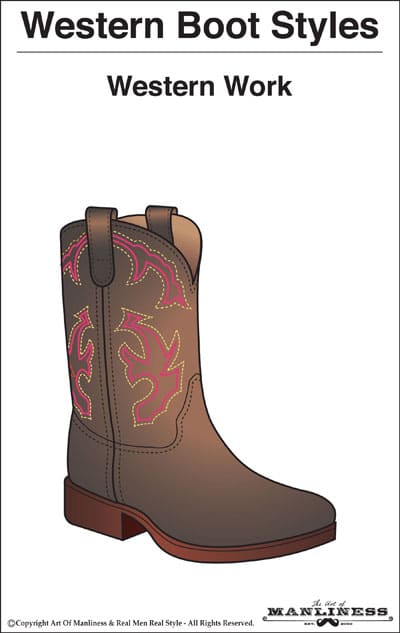
The Western work boot is very similar to the roper, although you’ll often find they have a larger toe box because they are frequently made with a steel toe. Rubber soles are common here for non-slip traction, as are shorter heels for the man who needs a work boot that’ll function in all conditions.
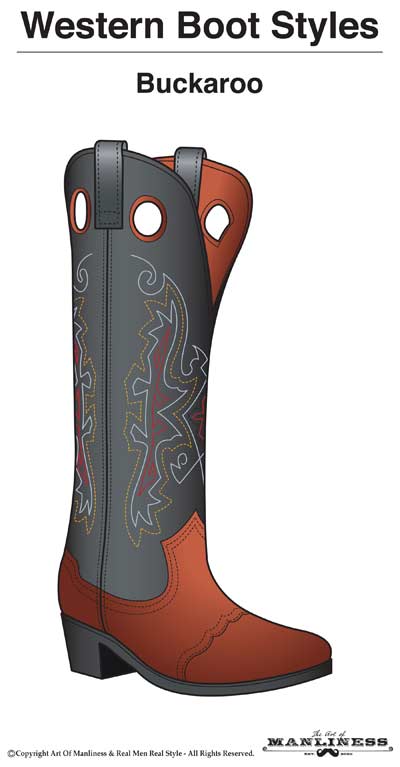
The buckaroo’s most distinguishing feature is its elongated shaft. Well past 14 inches, these shafts are often elaborately detailed to draw attention to the boot. A high heel and tall shaft make these a good choice for show riders — you’re able to protect your legs and have some style while doing so.
What to Wear With Cowboy Boots
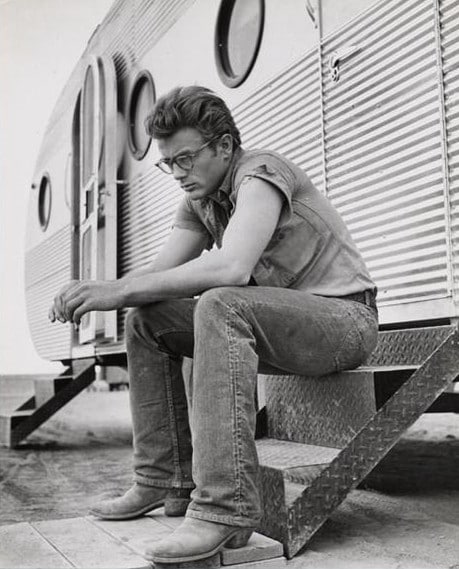
A good rule for Western-style outfits outside of the American Southwest is one western-themed item per outfit, maximum!
So if you’re wearing a pair of cowboy boots, wear them with a sleek belt and a jacket rather than with a cowboy shirt and a bolo tie. You want to look like you’re making a calculated fashion statement, not trying to dress up in a costume.
Your cowboy boots are going to be social wear rather than business (unless you’re a Texan), so plan to wear them with relaxed jackets and trousers:
- Collared shirts are something of a must with cowboy boots, if you’re wearing them to look stylish. A T-shirt and blue jeans with cowboy boots will fit right in at a country music show, but unless that’s where you’re actually going, you should wear something else. A plain white dress shirt works remarkably well, as do more patterned, casual shirts.
- Jeans should be dark and close-fitted, not the light blue of typical work jeans. You’ll want a boot-cut style for obvious reasons. Never tuck the jeans into the boots unless you’re doing actual work on horseback that requires it.
- Dress trousers can go with cowboy boots as well, and so can casual suits. Just make sure they have enough room in the leg that the boot shaft isn’t making a bulge.
- Jackets really help take you from “urban cowboy” to “snappy dresser.” I would almost tell you to never wear cowboy boots without a jacket, at least in a major metropolitan area. It just balances the casual boot style out in a way that a shirt on its own can’t.
- Hats are pushing it, but if you really want to hammer the cowboy point home, a nice felt Western-style hat is an obvious complement to Western boots. Don’t do this unless you’re really dedicated to making people instantly think “cowboy” when they look at you, though.
- Belts with decorative buckles or leather are always a good companion to cowboy boots. You don’t need a huge silver buckle with turquoise inlays, or a rattlesnake skin belt, but something a little more decorative than your average dress belt goes well.
- Denim or leather jackets are a good alternative to the dressier sports jacket. Don’t overdo the casual styling, however — your boots are already pretty casual, so a jacket with lapels is going to be better than one without. Alternatively, a long trench coat is a very natural pairing for Western boots. Avoid billowing leather dusters unless you’re trying to make a costume out of it.
- Spurs are for a few specific types of riding. If you’re not planning on hopping on a horse in the immediate future, please don’t wear spurs on your boots.
The goal of all these specific details is to make an outfit that acknowledges your boots without being centered around them.
You want to look comfortable, relaxed, and capable — all the things we associate with cowboys and Western culture.
If you’re in a big city, you also want to look a little dressier than an actual rodeo-going cowboy.
For a fail-safe cowboy boot outfit, try a pair of dark jeans, a white shirt, and a brown or gray jacket with a soft, casual cut. Add a decorative belt and a paisley pocket square to evoke traditional bandanas and you’re looking both stylish and unique.
Where You Should and Shouldn’t Wear Cowboy Boots
If we haven’t made it clear by now, Western-style boots are casual clothing.
They’re not business wear unless your business involves cattle or oil. Every once in a while you’ll see a businessman wearing a fancy suit with cowboy boots, but you don’t want to be that kind of eccentric.
For the most part we recommend keeping the cowboy boots to “fun” social events — things that are actively light-hearted, where a little machismo and a slightly more aggressive style isn’t out of place.
Good places for cowboy boots include:
- Most kinds of step dancing — salsa, square, etc.
- Bars
- Casual restaurants
- County/state/grange/etc. fairs
- Rock and country concerts
- Romantic evening picnics with a loved one
- Comedy shows (but if you sit in the front row they might say something)
- Absolutely any activity done on horseback
Questionable places to wear cowboy boots, unless they are a normal part of your personal style, include:
- First dates (might send the wrong impression)
- Political functions of any kind (even just casual fundraisers)
- Any presentation that you’re making personally
- Long hikes or drives (not comfortable for either)
- Upscale theater performances
- Modern dance clubs (wrong style, and often hard on the dance floor)
And of course there is some variance here depending on what your boots look like — a pair of white cowboy boots with bright red Texas stars on the toes are going to work in a lot less settings than a pair of deep, oxblood red boots with some decorative stitching in the same color thread. Exercise a little personal judgment, and if your boots are particularly gaudy, a little personal restraint as well.
Drawbacks: A Few Things to Watch For

Western-style boots were originally designed for riding. Some of their defining features are still more useful on horseback than they are on foot, though most manufacturers these days assume their customers are more likely to be making the rounds at a bar than a pasture.
A few things to watch for with your cowboy boots:
Sizing challenges. The lathes — foot-shaped molds — that each company uses to craft its boots are different, and often a guarded secret. A boot from one manufacturer might fit great, and a boot in the exact same size from the competitor will pinch. That makes cowboy boots especially hard to shop for online, or for people with unusual sizes.
Narrow toes. The extreme taper you see on a lot of boots is a recent stylistic development, and it’s not a very practical one. If you’ve got a broad foot, look for boots that start the taper relatively close to the toes and don’t narrow off too sharply. Too tight of a toe will make the boot chafe as you walk, or will put pressure on the toe bones, which will cause aching.
Break-in time. The high shafts and stiff sides of a cowboy boot take time to break in. Be aware that you’ll want a little bit of a loose feeling in the heel of a new boot — as the sides break in, your heel will slide further back and fill that. If you buy a brand new boot with no slippage, it’ll pinch the heel once it breaks in.
All in all, these are minor drawbacks — practical necessities of the boots’ working heritage, and easily overcome with a little time and savvy shopping. It’s a little more work than picking out a pair of new dress shoes, but the look you get from it is a lot more dramatic too.
Conclusion: The Western Boot in Non-Western Settings
Slipping a pair on for the first time may feel strange to a lifetime dress-shoe-and-sneakers man, but you’ll quickly come to enjoy the assertive sound of the heels and the elegant shape of the tapered toe.
Wearing a Western boot with a non-Western outfit is an exercise in the art of restraint and balance.
Let the boots talk for themselves, and keep the rest of the outfit simple and strong — values any cowboy can appreciate.
Watch a Video Recap
Written by:
Antonio Centeno
Click Here For My Free Style Ebook – The 7 Deadly Sins Of Style


